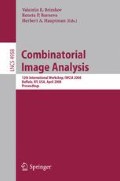Abstract
The purpose of this paper is to introduce an algorithm that can detect the most unusual part of a digital image. The most unusual part of a given shape is defined as a part of the image that has the maximal distance to all non intersecting shapes with the same form.
The method can be used to scan image databases with no clear model of the interesting part or large image databases, as for example medical databases.
Access this chapter
Tax calculation will be finalised at checkout
Purchases are for personal use only
Preview
Unable to display preview. Download preview PDF.
References
Fisher, Y.: Fractal Image Compression. Springer, Heidelberg (1995)
Hebb, D.: The Organization of Behavior: A Neurophysiological Theory. Wiley, New York (1949)
Hopfield, J.: Neural networks and physical systems with emergent collective computational properties. Proc.Natl.Acad.Sci.USA 79, 2554–2558 (1982)
Indyk, P.: Uncertainty Principles, Extractors, and Explicit Embedding of L2 into L1. In: 39th ACM Symposium on Theory of Computing, pp. 615–620 (2007)
Keogh, E., Lin, J., Fu, A.: HOT SAX: Efficiently finding the most unusual time series subsequence. In: Fifth IEEE International Conference on Data Mining, pp. 8–14 (2005)
Koroutchev, K., Korutcheva, E.: Bump formations in binary attractor neural network. Phys. Rev. E 73, 1–11 (2006)
Koroutchev, K., Korutcheva, E.: Bump formations in attractor neural network and their application to image reconstruction. In: The Proceedings of the 9th Granada Seminar on Computational and Statistical Physics, AIP, pp. 242–248 (2006)
Roudi, Y., Treves, A.: An associate network with spatially organized connectivity, JSTAT, P07010. pp. 1-20 (2004)
Ruderman, D.: The statistics of natural images. Network: Computation in Neural Systems 5, 517–548 (1994)
Tsodyks, M., Feigel’man, M.: The enhanced storage capacity in neural networks with low activity level. Europhys. Lett. 6, 101–110 (1988)
Author information
Authors and Affiliations
Editor information
Rights and permissions
Copyright information
© 2008 Springer-Verlag Berlin Heidelberg
About this paper
Cite this paper
Koroutchev, K., Korutcheva, E. (2008). Detecting the Most Unusual Part of a Digital Image. In: Brimkov, V.E., Barneva, R.P., Hauptman, H.A. (eds) Combinatorial Image Analysis. IWCIA 2008. Lecture Notes in Computer Science, vol 4958. Springer, Berlin, Heidelberg. https://doi.org/10.1007/978-3-540-78275-9_25
Download citation
DOI: https://doi.org/10.1007/978-3-540-78275-9_25
Publisher Name: Springer, Berlin, Heidelberg
Print ISBN: 978-3-540-78274-2
Online ISBN: 978-3-540-78275-9
eBook Packages: Computer ScienceComputer Science (R0)

